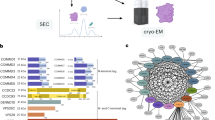Abstract
The excessive expression of catalase protein and its activity in cultured skin fibroblast from Zellweger Syndrome (ZS), a disorder of peroxisomal biogenesis, was found to be regulated at the translational level (J. Neurochem. 67: 2373-2378, 1996). Overall there is a considerable increase in the association of catalase mRNA with polysomes in ZS cell lines as compared to control indicating translational upregulation. To investigate the possibility that RNA-protein interactions are involved in the mediation of this increase in translation, the interaction between 3′ untranslated region of human catalase mRNA and human fibroblast cytoplasmic proteins were investigated by RNA gel shift assay technique. Competition experiments demonstrated that all the 600 bases of 3′ UTR (of human catalase gene) was required for efficient binding. Catalase RNA- protein interaction was sensitive to the altered redox state in these in vitro assays and this RNA-protein interaction could be enhanced by the addition of β-mercaptoethanol in cytoplasm from control fibroblast but not in cytoplasm from ZS fibroblast. UV cross linked RNA-protein complexes on SDS polyacrylamide gel electrophoresis revealed the presence of at least four protein bands with approximate molecular masses of 38 kDa, 50 kDa, 66 kDa and 80 kDa. The potential role of these mRNA binding proteins in the regulation of catalase gene expression is discussed.
Similar content being viewed by others
References
Cerutti P: Prooxidant status and tumor promotion. Science 227: 375-381, 1985
Subramani S: Protein import into peroxisomes and biogenesis of the organelles. Annu Rev Cell Biol 8: 513-518, 1993
Subramani S: PEX genes on the rise. Nature Genet 15: 331-333, 1997
Gould SJ, Kalish JE, Morell JC, Bjorkman J, Urquhat AJ, Crane DI: Pex 13P is an SH3 protein of the peroxisome membrane and a docking factor for the predominantly cytoplasmic PTS1 receptor. J Cell Biol 135: 85-95, 1996
Lazarow PB, Moser HW: Disorder of Peroxisomal Biogenesis. In C.R. Scriver, A.L. Beaudet, W.S. Sly (eds). The Metabolic Basis of Inherited Diseases. McGraw-Hill, New York, 1989, pp 1479-1509
Wanders RJA, Strijland A, Van Roermund CWT, Van den Bosch H, Shutgens RBH, Tager JM, Schram AW: Catalase in cultured skin fibroblasts from patients with the cerebro-hepato-renal (Zellweger) syndrome: normal maturation in peroxisomal deficient cells. Biochim Biophys Acta 923: 478-482, 1987
Singh I, Kremser K, Ghosh B, Singh AK, Pai S: Abnormality on translational regulation of catalase expression in disorder of peroxisomal biogenesis. J Neurochem 67: 2373-2378, 1996
Malter JS: Identification of an AUUUA-specific messenger RNA binding protein. Science 246: 664-666, 1989
Gillis P, Malter JS: The adenosine-uridine binding factor recognizes the AU-rich elements of cytokine, lymphokine, and oncogene mRNAs. J BiolChem 226: 3172-3177, 1991
Malter JS, Hong Y: A redox switch and phosphorylation are involved in the post translational upregulation of the adenosineuridine binding factor by phorbol ester and ionophore. J Biol Chem 266: 3167-3171, 1991
Klausner RD, Rouault TA, Harford JB: Regulating the fate of mRNA: The control of cellular iron metabolism. Cell 72: 19-28, 1993
Hentz MW, Rouault TA, Harford JB, Klausner RD: Oxidationreduction and the molecular mechanism of a regulatory RNAprotein interaction. Science 244: 357-359, 1989
Rouault TA, Tang CK, Kaptain S, Burgess WH, Hail DJ, Samaniego F, MacBride OW, Harford JB, Klausner RD: Cloning of the cDNA encoding an RNA regulatory protein–the human iron responsive element binding protein. PNAS 87: 7958-7962, 1990
Brown FR, Voigt R, Singh AK, Singh I: Peroxisomal disorders: Neurodevelopmental aspects. Am J Dis Child 147: 617-626, 1993
Vakalopoulou EJ, Schaack J, Shenk T A: 32 Kilodalton protien binds to AU-rich domains in the 3′ untranslated regions of rapidlly degraded mRNA's. Mol Cell Biol 11: 3355-3364, 1991
Clerch LB, Iqbal J, Massaro D: Perinatal rat lung catalase gene expression: Influence of corticosteroid and hyperoxia. Am J Physiol 260: L428-L433, 1991
Clerch LB A: 3′ untranslated region of catalase mRNA composed of stem-loop and dinucleotide repeat element binds a 69 KDa redox sensitive proein. Arch Biochem Biophys 317 (1): 267-274, 1995
Clerch LB, Massaro D: Oxidation-reduction-sensitive binding of lung protein to rat catalase mRNA. J Biol Chem 267: 2853-2855, 1995
Bohjanen PR, Petryniak B, June Ch, Thompson CB, Lindsten T: An inducible cytoplasmic factor (AU-B) binds selectively AUUUA multimers in the 3′ untranslated region of lymphokine mRNA. Mol Cell Biol 11: 3288-3295, 1991
Abate C, Patel L, Rauscher FJ III, Curron T: Redox regulation of fos and jun DNA binding activity in vitro. Science 249: 1157-1161, 1990
Zhang W, Wagner BJ, Ehrenman K, Schaefer AW, DeMaria CT, Crater D, Dehaven K, Long L, Brewer G: Purification, characterization and cDNA cloning of an AU-rich element RNAbinding protein, AUF1. Mol Cell Biol 13: 7652-7665, 1993
Clerch LB, Wright A, Massaro D: Dinucleotide-binding site of bovine liver catalase mimics a catalase mRNA-binding protein domain. Am J Physiol 270: L790-L794, 1996
Author information
Authors and Affiliations
Rights and permissions
About this article
Cite this article
Ghosh, B., Barbosa, E. & Singh, I. Characterization of fibroblast cytoplasmic proteins that bind to the 3′ UTR of human catalse mRNA. Mol Cell Biochem 209, 9–15 (2000). https://doi.org/10.1023/A:1007024119640
Issue Date:
DOI: https://doi.org/10.1023/A:1007024119640




